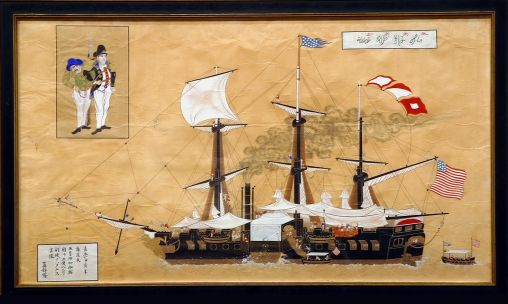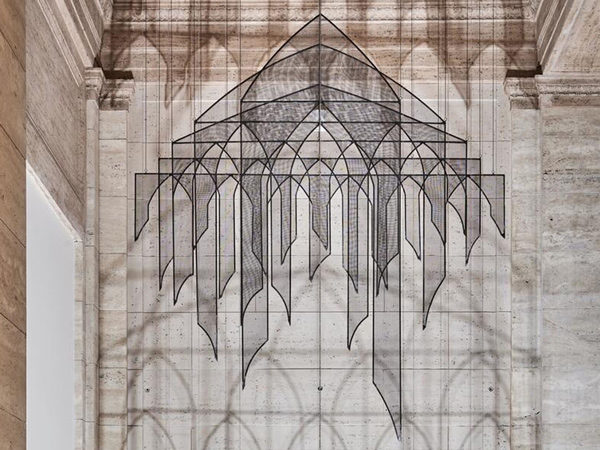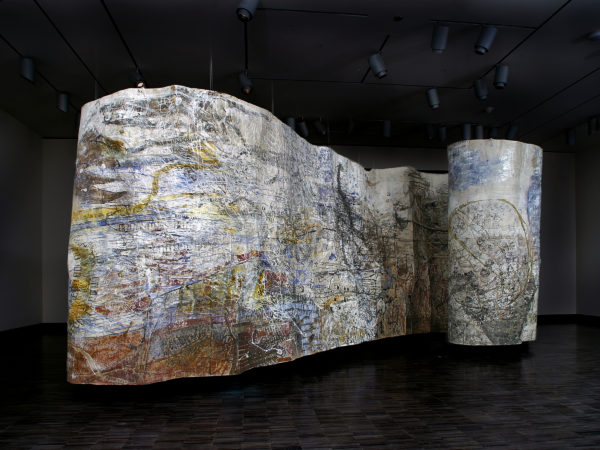Activity
The First Japanese Envoy to the United States

America: Depiction of an American Ship and Portraits of First Ambassador Perry and Deputy Ambassador Adams, 1854, by Shinsei (Japanese, active 1850s). Ink and colors on paper. Bequest of Marshall Dill, F2001.23.1.
Commodore Perry’s Black Ships
Commodore Perry’s Black Ships and the 150th Anniversary of United States–Japan Relations
The year 2003 marked the 150th anniversary of diplomatic relations between the United States and Japan. Until 1853, Japan and the United States, located on opposite shores of the vast Pacific Ocean, had almost no contact. By choice, Japan had maintained itself as a nation with closed borders for more than 200 years before this time, restricting foreign contact to relations with Dutch and Chinese traders, who were allowed access only to Nagasaki on the island of Kyushu. In contrast, the United States, faced with fierce international competition in the Pacific, aggressively sought new markets in East Asia. Thus, the establishment of relations with Japan became a popular topic for discussion in U.S. political circles.
In 1853, as directed by President Millard Fillmore, Commodore Matthew Perry sailed into Edo (now Tokyo) Bay, leading a squadron of four warships. The mysterious sight of their hulls, which had been blackened with tar to make them watertight, frightened the Japanese, who called them “black ships.” Commodore Perry gave President Fillmore’s letter for the emperor to high officials of the shogun and sailed away. He returned in 1854 to conclude negotiations with Japan, signing the Kanagawa Treaty on March 31. This treaty opened two ports, Shimoda on the Izu peninsula and Hakodate on the island of Ezo (now Hokkaido). By 1859, the so-called Five Treaty Nations — England, France, The Netherlands, Russia, and the U.S. — had all become trade partners with Japan.
In 1856, President Franklin Pierce sent Townsend Harris to Japan as the first U.S. consul to that nation. Harris worked on a draft of the Treaty of Amity and Commerce with the Japanese and invited them to visit Washington, D.C., for the formal signing of the final treaty. In 1860, this series of diplomatic events came to a climax when Japanese ambassadors came to the United States to present the treaty for ratification by the Senate.
These contacts between U.S. and Japanese diplomats fostered mutual understanding and respect. As a result, people began traveling between the two nations for business, study, and pleasure. Japan entered international society. American and Japanese import and export businesses flourished.
The First Japanese Envoy to the United States
In 1860, a Japanese diplomatic mission crossed the Pacific on the USS Powhatan, which had been Commodore Perry’s flagship during his 1854 expedition to Japan, to visit Washington, D.C. The Japanese delegation included three ambassadors and their officials and aides, two interpreters and their assistants, three doctors, 51 servants and guards, and six cooks, along with 50 tons of baggage and a large sum of money to cover their expenses.
Arriving in San Francisco on March 29, the Japanese turned south to Panama, where they traveled cross-country by steam train to the Caribbean coast. From there, they boarded another American warship, the USS Roanoke, for the final leg of their journey.
On May 14, 1860, they arrived in Washington, where they were ceremonially welcomed by President James Buchanan and other government officials. Though the parties knew little about each other, great hospitality and goodwill were shown by all concerned.
In retrospect, we know that diplomatic relations between the U.S. and Japan were established during a short span of peace just before the outbreak of violence in both countries. The United States became increasingly focused on internal problems, soon falling into civil war. In Japan, opinion was divided into pro- and anti-Westernization factions, resulting in civil unrest, which in part brought about the end of the Tokugawa shogunate in 1867. The Meiji emperor came to power, inaugurating a period of rapid modernization.





